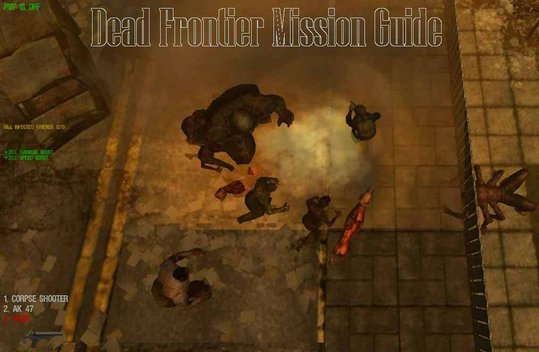
Scientific-Minimalist Guide to Dead Frontier Missions: Introduction

Missions provide an interesting break from Dead Frontier’s routine of Looting and Grinding. Twice a day at each outpost, missions are assigned, providing the citizens of Fairview with a chance to earn experience and money in return for completing tasks ranging from searching and looting to grinding and extermination.
If students following our course program have leveled up a build and purchased decent weapons, they should be reasonably well prepared to face the challenges offered by Missions.
HOW TO USE THIS GUIDE
The Scientific-Minimalist Guide to Missions is intended to be used as supplemental reading for the various Survival Courses taught at Zombie Hunter University (Survival 190: Nastya's Holdout, Survival 290: Dogg's Stockade, Survival 390: Precinct 13; Survival 490: Fort Pastor).
This guide will educate students regarding minimum necessary requirements needed to complete missions in each outpost. Topics covered include:
- What is the goal of each mission?
- What are the challenges (aggro, bosses, difficult looting)?
- Which weapons and skills are required to overcome those challenges?
Although intended as a supplement to course work, the guide stands on its own and may be used by students or interested parties not pursuing a graduate line of study.
MISSION OVERVIEW
Each outpost offers two missions per day, one after the other, with an hour-long gap in between. Citizens who wish to participate click "Accept" when the mission offer appears on screen (automatically) in the outpost. After accepting, participants must complete the mission before its time runs out; this means going to the designated area, completing the task, and returning to the outpost to collect the reward.
Rewards consist of Experience Points and Cash. Gold Members receive double rewards.
MISSION TYPES
There are essentially three types of missions, though they sometimes overlap:
- Loot Missions: retrieve some kind of Loot.
- Extermination Missions: kill a certain kind and/or number of zombies.
- Search-and-Rescue Missions: find a missing person.
The mission descriptions are sometimes misleading: for example, students may be asked to “find” a missing person, who turns out to be dead, so instead students end up looting proof of the character’s demise.
- LOOT MISSIONS
These rank among the easiest missions. Students simply need to find a certain number of a particular item – sometimes only one.
In many cases, the required items will be found in specified loot spots. For instance, gasoline will be found in vehicles; students do not need to search other loot spots.
Often aggro is low, though in more advanced outposts the missions tend to be complicated by high aggro, making them more difficult.
In some cases, so-called Loot Missions are de facto Extermination Missions in disguise. If students are asked to loot ten blood samples from a particular kind of zombie, students will need to exterminate dozens, perhaps hundreds, of zombies before they can obtain all the samples needed.
- EXTERMINATION MISSION
These can be more difficult, depending on the species and number of zombies to be eliminated. Later missions involving Spiders, for example, are quite challenging; even relatively easy-to-kill zombies (e.g., Flaming Zombies) can become dangerous when encountered in large numbers.
Some Extermination Missions have elements of Search-and-Rescue Missions. Students may be asked to meet up with personnel in the mission area. Even after the requisite number of zombies have been killed, the mission will not be complete until the student has talked to the personnel.
If students are lucky, the personnel will remain in the mission area to help exterminate the zombies; this is particularly useful when students are at freshmen level with weak weapons. In other cases, however, the personnel will bug out after being rescued or relieved of duty.
- SEARCH AND RESCUE MISSIONS
These missions are simple but challenging, due to complications from aggro.
In the mission area, the small GPS window in the upper right screen will display the missing person as a green dot if he/she is nearby. We advise our students to attempt this mission on their own, so as not to be distracted by green dots representing other survivors.
The difficulty arises after the target has been located. In Search-and-Rescue Missions, it is not enough to simply find the missing person; it is necessary to converse with him/her. The conversation consists of standing nearby while the missing person speaks, usually several times.
Unfortunately, the missing person usually will not speak while there are zombies in the area, and trying to fight them off is a Sisyphean task.
Instead, we suggest that students lead the aggro away, running around the block and then returning to the missing person, who will hopefully speak before the zombies catch up. Students may have to repeat this process a few times before the missing person finishes speaking.
SCIENTIFIC MINIMALIST APPROACH TO MISSIONS
As students progress from one outpost to the next, they will encounter new and more dangerous missions that require improved skills and better equipment. But how much skill and exactly what equipment?
Any graduate student with a Mini-Gun and a Grenade Launcher could backtrack to Nastya’s Holdout, Dog’s Stockade, or Precinct 13 and walk through the missions with about as much difficulty as The Terminator taking out a police station. That may be fun, but it is not challenging. Nor is it the fashion in which most students approach missions, working their way up from outpost to outpost while leveling up their builds.
The Scientific-Minimalist Guide to Missions will make some assumptions about how long students stay in different outposts while working on their stats and proficiency. Most of those assumptions will be based on our recommended templates in our Scientific Minimalist Guide to Builds though in some cases we will note when students would be better off using a more advanced weapon than the guide suggests they have at the outpost where the mission takes place.
If a student is working on a different kind of build, some of our suggestions may not seem apropos. We will try to take other options into consideration – for instance, what if the student is using rifles instead of melee weapons? Whatever the case, we will keep an eye on the elusive intersection between what can be realistically achieved at the expected level for a particular outpost and what is needed to successfully complete missions at that outpost.
WARNING: POSSIBLE OUT-OF-DATE INFORMATION
Most of these mission guidelines were posted before the Wastelands were added to Dead Frontier. At that time, the map of Fairview changed considerably, with many areas undergoing major renovation to replace existing structures (fences, buildings, parking lots, etc) with new ones.
Consequently, references to specific details of the mission areas may be out of date. Fortunately, our recommended mission strategies will still be effective.
What does this mean, exactly? If we recommend hiding behind a fence to kill a boss zombie, that advice remains good. But references to a specific fence (such as one around a parking lot on the southwest corner of a block) should not be trusted until we can revisit the missions to confirm the continued existence of these structures.
SCIENTIFIC MINIMALIST GUIDE TO MISSIONS: CHAPTERS

Matriculated
1254495